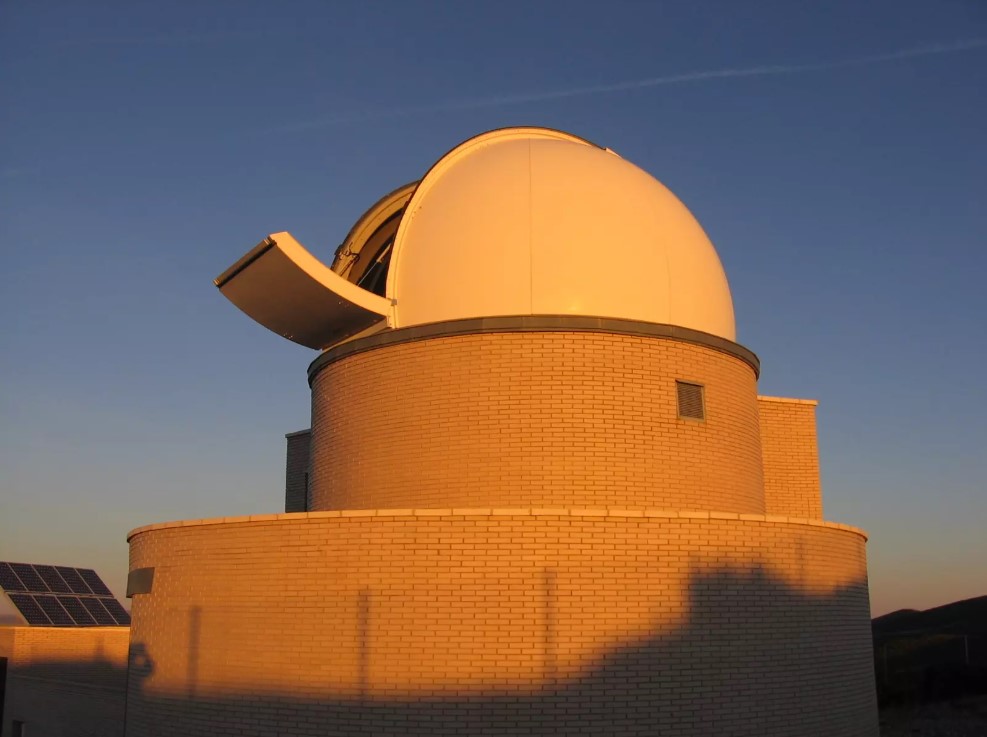The OADM’s TJO is involved in monitoring the approach of the BepiColombo probe

Telescopes around the world have coordinated to track this approach
The Joan Oró Telescope (TJO) at the IEEC's Montsec Astronomical Observatory (Observatori Astronòmic del Montsec, OAdM) was one of them
On 10 April 2020, the European Space Agency's (ESA) BepiColombo probe completed its first and only approach to Earth, passing less than 12,700 km from the surface of our planet, on its way to its final destination: Mercury.
Launched in 2018, BepiColombo is on its seven-year journey to the smallest and least explored planet orbiting the Sun, which contains important clues about the formation and evolution of the entire Solar System. The mission is a joint effort between ESA and the Japan Aerospace Exploration Agency (JAXA), carried out under ESA's leadership.
This approach is the first of nine flights that, together with the solar propulsion system the probe carries on board, will help it reach its orbit around Mercury. The next two flights will take place on Venus and the other six on Mercury itself. Scientists will use the data collected during the flyby, which includes images of the Moon and measurements of the Earth's magnetic field as the spacecraft passed by at full speed, to calibrate the instruments that, starting in 2026, will investigate Mercury to solve the mystery of how it formed, make a cartographic map and study the magnetosphere. In addition, ESA's Planetary Defence Office is using this flight as proof of its ability to coordinate asteroid observations with a non-nil probability of impacting our planet.
ESA's NEO Coordination Centre (NEOCC) coordinated many telescopes from around the world to track the probe's position and brightness as it passed over the Earth.
The TJO involved in the monitoring
The Joan Oró Telescope (TJO) at the Montsec Astronomical Observatory (OAdM) is one of the telescopes that participated in the monitoring of the BepiColombo probe as it passed very close to the Earth. A set of 98 images, 20 seconds exposure time each, taken with the TJO on 10 April 2020 is shown in video format.
"Observing an object with an apparent movement as fast as the BepiColombo is quite a challenge for a telescope. The TJO has allowed us to track the object up to 6 days after approaching the Earth, when the object already had a magnitude of 20.5. The TJO is certainly one of the few telescopes on the peninsula capable of making this type of observation," said Toni Santana-Rubio, IEEC researcher at the Institute of Cosmos Sciences (ICC, UB) and the Department of Physics, Systems Engineering and Signal Theory at the University of Alicante.
The OAdM, of the Institute of Space Studies of Catalonia (IEEC), is dedicated to carrying out research programmes in space sciences and satellite operations control. The TJO and the entire OAdM in general, including the TFRM telescope, participate in international near-Earth monitoring programmes financed by the EU and ESA, among others. These programmes are dedicated to the detection and tracking of both near-solar system objects (NEOs) and artificial satellites.
Links
More information
The Institute of Space Studies of Catalonia (IEEC — Institut d’Estudis Espacials de Catalunya) promotes and coordinates space research and technology development in Catalonia for the benefit of society. IEEC fosters collaborations both locally and worldwide and is an efficient agent of knowledge, innovation and technology transfer. As a result of over 20 years of high-quality research, done in collaboration with major international organisations, IEEC ranks among the best international research centers, focusing on areas such as: astrophysics, cosmology, planetary science, and Earth Observation. IEEC’s engineering division develops instrumentation for ground- and space-based projects, and has extensive experience in working with private or public organisations from the aerospace and other innovation sectors.
IEEC is a private non-profit foundation, governed by a Board of Trustees composed of Generalitat de Catalunya and four other institutions that each have a research unit, which together constitute the core of IEEC R&D activity: the University of Barcelona (UB) with the research unit ICCUB — Institute of Cosmos Sciences; the Autonomous University of Barcelona (UAB) with the research unit CERES — Center of Space Studies and Research; the Polytechnic University of Catalonia (UPC) with the research unit CTE — Research Group in Space Sciences and Technologies; the Spanish Research Council (CSIC) with the research unit ICE — Institute of Space Sciences. IEEC is integrated in the CERCA network (Centres de Recerca de Catalunya).
Videos
PR Video 001
Monitoring of the BepiColombo probe as it passed very close to the Earth by the TJO on 10 April 2020. The video is made from a set of 98 images, of 20 seconds exposure time each.
Credit: images, Toni Santana-Ros (ICC/IEEC-UB); video, Pere Gil (OAdM/IEEC).
Contacts
IEEC Communication Office
Barcelona, Spain
Rosa Rodríguez Gasén
E-mail: comunicacio@ieec.cat
Institute of Space Studies of Catalonia
Montsec Astronomical Observatory
Barcelona, Spain
Marc Ribó
Scientific Director
Email: mribo@ieec.cat
Josep Colomé
Technical Director
Email: colome@ieec.cat
Institute of Cosmos Science
Barcelona, Spain
Toni Santana-Ros
Postdoctoral Researcher
Email: tsantanaros@ieec.cat
